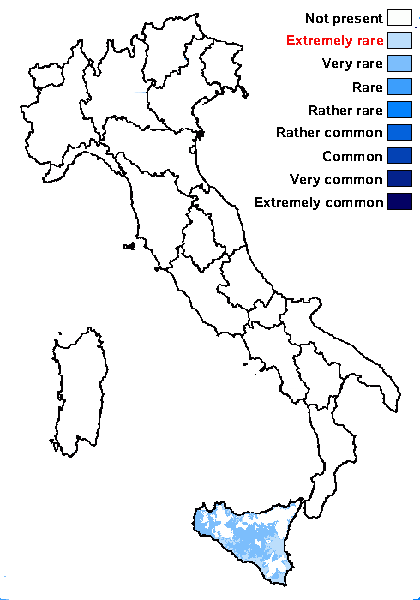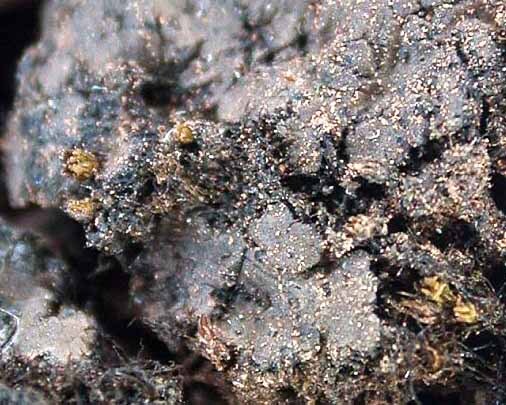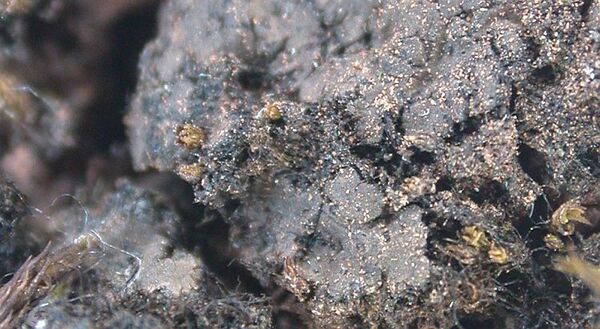Endocarpon simplicatum (Nyl.) Nyl.
in Hue, Rev. Bot. Bull. Mens,. 6: 104, 1888.. Basionym: Verrucaria simplicata Nyl. - Flora, Regensburg, 67: 390, 1884.
Synonyms:
Distribution: S - Si (CLU 10478).
Description: Thallus squamulose, heteromerous, the squamules pale to dark brown, scattered or contiguous, 1.5-6(-8) mm wide, 0.15-0.4 mm thick, rounded to deeply lobate, flat and fully adnate or concave with upturned, often undulate, slightly thickened and black-rimmed margins; lower surface brown-black, attached by conspicuous, up to 10 mm long, black, branched rhizines, without rhizohyphae. Upper cortex 30-50 µm thick, of angular, isodiametrical or anticlinally slightly elongated cells, overlain by a 10-30 µm thick epinecral layer; medulla white, of interwoven hyphae; algal layer c. 50-80 µm thick, the algal cells arranged in vertical columns; lower cortex paraplectenchymatous, brown-black, 25-40(-50) µm thick. Perithecia black, broadly pyriform, immersed, up to 0.4 mm across (in section). Exciple black, often paler near the ostiole; hymenium colourless, I+ brown-red, filled with either globose and 3-4 μm wide or ellipsoid and up to 5 x 3 μm hymenial algae; periphyses 40-70 µm long, paraphyses absent. Asci 1-spored, clavate to cylindrical-clavate, bitunicate, with a fissitunicate dehiscence, thin-walled, the wall non-amyloid. Ascospores muriform, yellowish brown to brown, elongate-ellipsoid or narrowly clavate, (47-)65-90(-110) x 23-36 µm. Pycnidia black, immersed, up to 0.2 mm across. Conidia hyaline, bacilliform, 3-4.5 x c. 0.8 µm. Photobiont chlorococcoid (probably Diplosphaera), present in both thallus and hymenium. Spot tests: cortex and medulla K-, C-, KC-, P-, UV-. Chemistry: without lichen substances. Note: a widespread terricolous species also known from the Southern Hemisphere, growing on clay soils in opening of Mediterranean garrigue vegetation. Probably more widespread in Mediterranean Italy.
Growth form: Squamulose
Substrata: soil, terricolous mosses, and plant debris
Photobiont: green algae other than Trentepohlia
Reproductive strategy: mainly sexual
Commonnes-rarity: (info)
Alpine belt: absent
Subalpine belt: absent
Oromediterranean belt: absent
Montane belt: absent
Submediterranean belt: very rare
Padanian area: absent
Humid submediterranean belt: absent
Humid mediterranean belt: very rare
Dry mediterranean belt: extremely rare

Predictive model
Herbarium samples
Growth form: Squamulose
Substrata: soil, terricolous mosses, and plant debris
Photobiont: green algae other than Trentepohlia
Reproductive strategy: mainly sexual
Commonnes-rarity: (info)
Alpine belt: absent
Subalpine belt: absent
Oromediterranean belt: absent
Montane belt: absent
Submediterranean belt: very rare
Padanian area: absent
Humid submediterranean belt: absent
Humid mediterranean belt: very rare
Dry mediterranean belt: extremely rare

Predictive model
| Herbarium samples |
 INDEX FUNGORUM
INDEX FUNGORUM
 GBIF
GBIF



